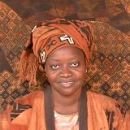textile artists, painters, Mali
After graduating from the INA, they traveled throughout Mali to research the traditions and practices of bogolan. The most important findings had to do with the symbolic alphabet, the traditional structure, the traditional uses and the symbolism of the traditional colors encoded in the bogolan cloths used as skirts by women (pagnes). This information enabled the Groupe to read the significance and the teachings of the cloths.
The Groupe abandoned modern painting in favor of the traditional technique of bogolan. Western art materials are and were very expensive in Mali. Paint, paper, brushes and the rest have to be imported from Europe. This pushed the Groupe to use the traditional art materials which exist in Mali.
The name of the Groupe, Kasobane, means in bamanankan, prison is finished, we are free. Free from the need to express themselves creatively with materials that are not their own. Free to use the materials which occur naturally in Mali and which are embued with a wealth of tradition and significance.
Until this time, mudcloth had been used only for clothing. The Groupe moved the technique of mud-cloth from craftsmanship to art. The innovation lies in the compositions, the style, the color range and in the presentation of works.
The art of the Groupe Bogolan Kasobane is tied to the context in which the work is conceived and elaborated. It is the consequence of a collective inspiration, the joy of the work and is rooted in the community tradition of Malian society.
It is this intimate and specific connection to Malian culture that distinguishes the art of the Groupe. In order to appreciate the work, viewers must be open to reading or learning at least a bit of the symbols and traditions of Mali. The work blooms in the symbiosis of traditional and contemporary art.
With their collective creations, the artists of the Groupe go beyond the individualism, the subjectivity and the 'I' that comes from the West. In the artistic practice of the Groupe, whether the inspiration is collective or individual, there is always the intervention of the Groupe in the points of disagreement and difficulty that inevitably arise. When the sources of inspiration are collective, the composition is execuited communally as well and the final realization is given to one of the members of the Groupe who is the most interested in the chosen theme. The work is always finished by the whole group.
Over the course of the Groupe's twenty years of collective work and with the close ties that have developed between the artists, the reciprocal influences have played an important role in unifying the work of the Groupe. This work has become a school of thought that is ripe for inspiration both for the Groupe itself and for other artists as well.
Today the Groupe is known because of their numerous exhibitions in Mali and around the world. In 1995, American artist Janet Goldner became interested in the Groupe and their work while in Mali on a Fulbright research grant. When she returned to the United States, she began to explore exhibition opportunities for the work of the Groupe in New York and in the United States.
Since 1994, The Groupe Bogolan Kasobane has been responsible for the costumes and sets for many films including Malian directors Cheick Oumar Sissoko¹s Guimba and Adama Drabos Taafe Fange (Skirt Power). Their work received first prize for Guimba at FESPACO, 1995 in Ouagadougou. This was the first time in the history of FESPACO that a prize was given for costumes and sets. Taafe Fanga received the prize for art in Japan.
The costumes from the Lincoln Center exhibition were shown at The Kennedy Centers (Washington, DC) African Odyssey program as part of the African Mosaique- Haute Couture fashion show presentation in May 1998. The show featured the work of 33 African and African American designers and was hosted by Mrs. Colin Powell.
The Groupe maintains a studio and shop in Bamako and a gallery in Segou, Mali.





